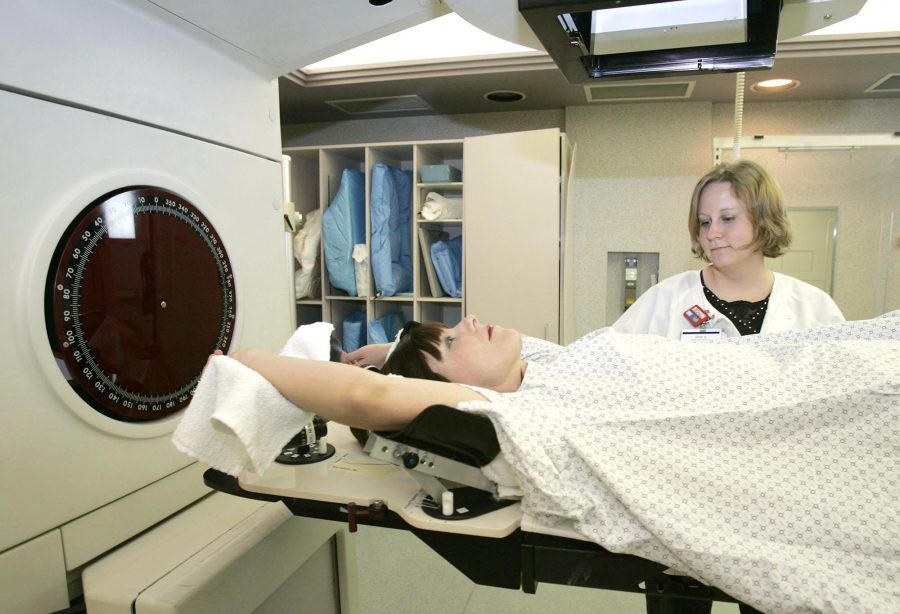The National Comprehensive Cancer Network paints a straightforward picture of the best lymphoma treatments, but recent UPMC research found that reality doesn’t reflect this depiction.
Dr. John Austin Vargo, a UPMC radiation oncologist, led a study investigating what he calls one of the “shortcomings of our nationwide healthcare system,” the underutilization of radiation therapy in early-stage follicular lymphomas. Vargo published the work this August and found that, despite strong clinical evidence that shows radiation therapy leads to higher overall survival rates than alternative treatments, patients are receiving either no treatment, chemotherapy or targeted drug therapies.
“It’s frustrating that, despite it being the recommended treatment, radiation therapy is underutilized,” said Vargo. “The role of oncologists is only to perform the treatment. In terms of deciding what treatment patients should receive, they are at the end of the referral chain.”
Follicular lymphoma is the most common type of of non-hodgkin lymphoma, a form of blood cancer that occurs when white cells grow, spread and form tumors in the body. NHL will affect 71,000 people in 2015, according to the American Cancer Society.
Of these 71,000 people, doctors will diagnose 20 to 30 percent with FL.
Three main types of treatment exist for FL patients: non-treatment, chemotherapy and radiation therapy. RT is the use of high energy X-rays to target tumors in the body, and studies by the National Comprehensive Cancer Network have found that it is the best treatment for FL in its early stages.
Vargo and his team analyzed treatment methods and survival rates for 35,961 patients in stage I and II FL, the group of patients who he said should receive radiation therapy. Following the analysis, the radiation oncologists evaluated the types of treatment these patients actually received, whether it was chemotherapy or RT, and compared overall survival rates based on treatment type.
The study found that the use of RT in patients with FL decreased from 37 percent in 1999 to 24 percent in 2012, paralleled by increases in the use of chemotherapy and observation without initial radiation treatment. Those who initially underwent RT had five and 10-year survival rates of 86 and 68 percent, respectively, while those who didn’t experienced survival rates of 74 and 54 percent.
“Some of [the decline] is due to misconceptions,” Vargo said. “Radiation is associated with an increased risk of second cancer.”
Vargo said modern techniques and research has proven these beliefs wrong.
“Older radiation techniques [achieved] less accurate delivery, which increased side effects, [but] the bias of an increased risk of toxicity is less of a concern [with] modern radiation techniques,” Vargo said.
The declining use of RT despite recommendations also “stems from a bias toward physicians choosing no treatment [at all] because FL is a slow-growing cancer, and patients may die of other things before [they do of] lymphoma,” Vargo said.
According to Jennifer Wilson from the Information Resource Center at the Leukemia and Lymphoma Society, RT is a viable treatment option for NHL cancer that is localized in one part of the body.
“If [the FL] is in stage I or II, [oncologists] may look at radiation because the disease is localized,” Wilson said, “but [often] when follicular lymphoma is actually diagnosed, it’s [past] stage I or II. It’s spread throughout the body,” Wilson said.
Vargo said he also found social factors, such as sex and race, often determine overall utilization rates of RT for those with early-stage FL.
“I was concerned that we were seeing certain patients at some UPMC institutions but not at others. It made me wonder whether these patients were receiving other therapies and how those therapies were affecting their outcomes,” said Vargo.
Pittsburgh radiologist Dr. Carl Jueng said deciding on a treatment method “depends strongly on the extent of the disease” and depends on the age and general health of patients.
“If the tumor is not well-localized, a systemic treatment, [one under which drugs spread through the entire body], such as chemotherapy would be used as opposed to radiation,” said Jueng. “If [patients] are at a higher stage [of FL] at the time of diagnosis, radiation would be a less beneficial treatment.”
Although health care sometimes covers the cost of radiation therapy, it can still cost upwards of $10,000, but Vargo said the one-time price is worth the long-term results.
“While the cost [of radiation] may be a perceived negative, I would argue that three weeks of radiation is cheaper than alternatives like chemotherapy,” said Vargo.
According to the Lymphoma Research Foundation, radiation provides a cure for patients with a “limited disease,” but doctors often use chemotherapy and various drugs to treat more advanced stages. According to CA, a Cancer Journal for Clinicians, chemotherapy is usually the first option for all subtypes of NHL. Physicians prescribe chemotherapy along with RT 11 percent of the time and without radiation therapy 56 percent of the time. Clinicians deliver RT without chemotherapy 7 percent of the time.
Vargo said it is “difficult to change” this decreasing trend, but hopes that, by publishing his results, patients and physicians will be more cautious in eliminating RT as a treatment option in early-stage FL.
“It was rewarding seeing our results align with those of the NCCN,” Vargo said.



